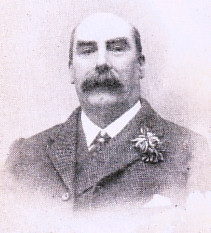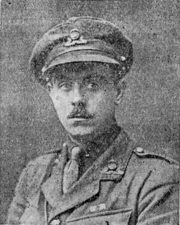x


James Kinna
1829 - 1897
+
Ann Green
1822 - 1906
married 1853
Mary Jane Hannah
1859 - 1937
+
James Green Kinna
1854 - 1911
†—
Ellen Kinna
1857 - 1926
—
William Kinna
1860 - 1860
Ethel Ffarington Kinna
1883 - ?
married 1905
—
James E Kinna
1889 - 1916
†—
Kenmuir Kinna
1894 - 1964
†+
+
Leon Colegate
1879 - 1953
Gladys Burton
1897 - 1992
married 18919
Gabrielle E Colegate
1906 - ?
married 1930
+
Derek Albert W Turner
1903 - ?
Alison R C W Turner
1936 - ?
—
Robin M I W Turner
1946 - ?
John Kinna [4]
1831 - 1895
+
Jane Gimmell
1830 - 1911
married 1859
Sibella Kinna
1860 - 1947
m 1887
—
Matilda Kinna
1862 - 1870
—
Jane Kinna
1864 - 1870
—
Janet Gimmell Kinna
1866 - 1949
—
Mary Kinna
1867 - 1954
—
Sarah Kinna
1869 - 1946
—
John Alexander Kinna
1871 - 1933
+
William Miller
1859 - 1939
Click on the † for further information.
People with ↟ have further decendants. click to visit.
James Eckersley born 8th November 1889 in Crebridge Minnigaff. In the 1911 census James is shown as an electrician and living at home in 40 Bignor Street, Cheetham.
An obituary, below, appeared in the local paper and included his photograph.
LIEUT. J.E.KINNA, M.C (died of wounds)
We regret to record the death of Lieutenant Jas. Eckersley Kinna, the elder son of the late Mr James G Kinna, whose name, as a frequent contributor to our columns, will be Familiar to most of our readers. He was born at Riverstead, Creebridge, but when still young his family moved to Manchester, where his mother still resides. On the outbreak of war he enlisted in the 9th Battalion Royal Scots and served for a considerable time in France with that battalion. Later he received a commission and was posted to the 11th Battalion Lancashire Fusiliers, with which he saw much further service at the front. Last year he was awarded the Military Cross for gallant conduct in the field. The official record announcing the award stated that Sec.-Lieut. Kinna, as he was then was 'when in command of an assaulting party showed conspicuous courage and initiation in leading his men and repelling counter attacks. By his cheerfulness and confidence he inspired his men in critical situations'.
Shortly after winning this distinction, Lieut.Kinna came home on leave and while in England his health broke down, and he was for a long time under Doctor's orders.
Part of his convalescence he spent in Newton Stewart where he was well known. In June last he was able to take up light military duties and on the 8th of this month he was able to return to his regiment. He joined it on the 10th or 11th and died of wounds on the 12th. He was 27 years of age. Much sympathy will be felt for his mother and brother.
At the end of May 1917 he was admitted to hospital suffering from delusions, and had a guard placed over him, according to his Officer Commanding it was Alcoholism. After discharge he applied for a posting to East Africa and at first it was all agreed but then stopped by the Brigade Commander. His brother Kenmuir was serving in Bagdad at the time, perhaps it was to be together. On the 12th September he walked out of the mess tent and shot himself in the head, there were several witnesses. Some documents in his file say he died of wounds in action, and this was the impression given to his Mother, but she was obviously not satisfied and ultimately received a letter on the 1st November with the facts and also stating he was suffering from 'Chronic Brights Disease'.
The Death Certificate (12-9-1917) states he died from wounds accidentally received. The Dumfries & Galloway Standard dated 29-9-1917, noted the fact that he 'Died of Wounds'. He is buried in the Etaples Military Cemetery XVII. B. 28.
Kenmure Kinna FRIBA born 11-6-1894 died 22-6-1964
Married 1919 to Gladys née Burton born 9-5-1897 died December 1992 .
He attended the Cheetem Higher Grade School and then the Manchester Muncipal School of Art (1909), in October 1911 he was awarded a medal for best model aircraft, he was also Hon.Sec. of the Manchester Model aero Club. At this time Kenmure was living at 40 Bignor Street Cheetham with his parents. He entered the Army as a Private with the 15th Battalion Royal Scots in September 1914 and was commissioned into the Loyal North Lancashire Regiment in July 1915. He entered the Mesopotamia theatre of war with the 6th Battalion 'Loyals' from 22-11-1916 to 17-4-1919, with the rank of Temporary Lieutenant. He served in India during July-October 1919. Kenmure received the British War and Victory Medal, the India General Service 1908-35 Medal, 1 clasp, and the Afghanistan N.W.F. 1919 (North West Frontier),and was discharged 12-10-1919.
After the war he settled in Liverpool, but lived in Wallasey, and trained as an Architect and practiced in Liverpool from 1921 as Kinna-Mackey at Liberty Buildings School Lane, the partnership was dissolved in November 1923. By 1926 Kenmure was at 14 Castle Street, and in 1935 he was made Fellow of Royal Institute of British Architects.
He lived at 'Iraq' 169 Seabank Road Wallasey, may be the house was named after his war experiences. In the 20's he was a member of the "Liver Sketch Club". He entered local politics in 1949 and became an Alderman in 1962; he was chairman of the Wallasey Conservative Association from 1956 to 1959. He had married in 1919 but did not have any children.
Kenmure a Director of the Liverpool Stadium and was appointed chairman of the New Brighton Tower Company in January 1964. He had been Technical advisor to the company for some 15 years and a member of the board for five years. The Liverpool Stadium situated in St Paul's Square, Bixteth Street, was Britain's only purpose-built boxing arena. Built on the site of St Paul's Church, it was designed by Kenmure, and built in 8 months at a cost of £30000. It was opened in 1932. The last professional bout was in 1985, and it was demolished in 1987. Apart from boxing it was used for pop concerts, mass meetings, circuses, and bingo. Louis Armstrong and the Liverpool Philharmonic Orchestra gave concerts there. The Foundation Stone now displayed in the Museum of Liverpool.
Kenmure also designed the Regal Cinema at Norris Green, it was the first cinema to be built in the city, specifically designed for 'talkies' . It opened on 27th January 1930 with Charles King in 'Broadway Melody'. The building was in the Art Deco style and had 1756 seats. Located in the Norris Green district of north-east Liverpool, the Regal was built to serve, what was in the early-1930's, Liverpool's largest new housing estate.
The Regal was taken over in 1935 by ABC. In 1955 CinemaScope projectors were installed, but it closed on 6
thAugust 1955 for a £20,000 makeover, with the introduction of 'tip up' seats.
The Regal was reopened on 10
th October 1955 with a double bill of
Such Men are Dangerous starring Kirk Douglas and
Circle of Fear starring Charles Starrett. The audiences improved for a while but over the next few years gradually fell until in 1963 Mecca Bingo was introduced. This proved successful and finally took over on 10
th October 1964. and continued until 2007, when the building was put up for sale.
[When I visited the site in August 2019 the building was still unsold and looking rather sad.]
The Liverpool Stadium
In the programme for the opening night of the Liverpool Stadium, architect Kenmure Kinna offered this description:
"The new Stadium, unique in conception and design, is an example of the modern style building. steel framed (of British Steel) and clothed with brickwork of a pleasing grey colour, with a large central feature faced in Terra Cotta. The roof is supported on steel trusses, and is the largest span of its kind in Liverpool, being 120 ft between supports. The levels of the main hall have been decided so that everyone has a clear view of the ring from any part of the building, and thus has arisen the saucer shape which was prevalent in the days of the gladiators.
Of special note, added Kinna, was the 35,000 candle power lighting rig above the ring; its glare shielded from spectators by a suspended board showing the number of the round being fought. Also innovative was the actual ring Instead of 'the usual buckets', sinks were plumbed in under each corner, while the ring structure was designed to be easily dismantled so other events might take place". In the 1950s these included circuses, religious meetings, political rallies addressed by Winston Churchill and Clement Attlee. and informal classical concerts, aimed at workers deemed unlikely to attend the Philharmonic. During World War II boxing shows were staged there to maintain morale, in 1944 there was a guest appearance by the US Army's ambassador, world heavyweight champion Joe Louis (who, as a publicity stunt during his visit, signed for Liverpool FC).
Obituary 22nd June 1964
Alderman Kenmure Kinna dies at 70 after collapsing at the Tower
NOTED ARCHITECT AND CHAIRMAN OF THE HOUSING COMMITTEE AND CHAIRMAN OF THE NEW BRIGHTON TOWER COMPANY
Tributes to Alderman Kenmure Kinna at Thursday's Council meeting were led by the Mayor, Alderman Mrs. M. Lyons, who said that the Council and the town would greatly miss his service. A member for North Liscard ward since 1949, he had served on various committees both within and outside the Council, and for nine years as chairman of the Housing Committee. Alderman Kinna, she said, a kindly man who would be greatly missed. She had sent a letter to his widow expressing the Council's deep sympathy. Leader of the Council, Alderman C. G. E. Dingle said that Alderman Kinna had a fine record of public service to the town. 'I have never heard him say anything unkind about another person' he said. 'He was liked and respected by all his colleagues on the Council - a personality who will be missed from this Town Hall and from these benches'. Adding his tribute to Alderman Kinna's kindness, Councillor Bill Wells, Labour leader. said it was typical of him that one of the last things he did was to stop an eviction order on Friday of last week. Speaking for the Liberal group, Councillor P. H. Williams described Alderman Kinna as 'a kindly and pleasant man who never bore any malice'. The Mayor (Alderman Mrs. M. Lyons) led the large party of civic mourners which joined family mourners and friends at yesterday's funeral The service at Emmanuel Church, New Brighton, was followed by interment at Landican Cemetery'.
Kenmure was buried in the same grave as Charlotte Burton, her husband Robert Latham Burton. The grave is in the CoE section 2, grave number 1.






